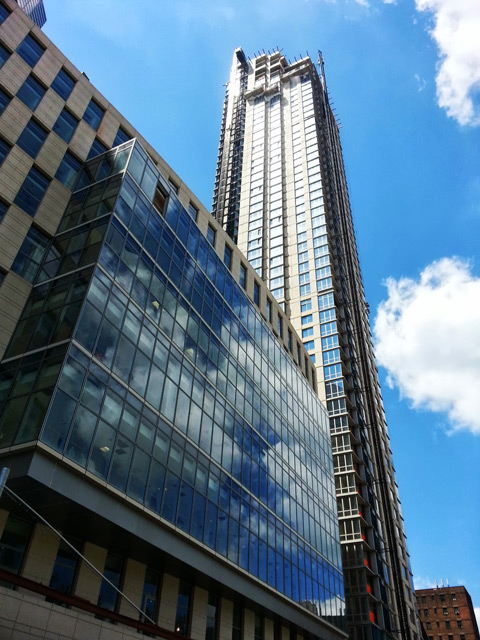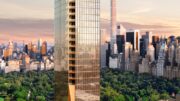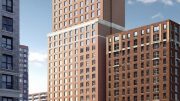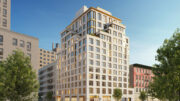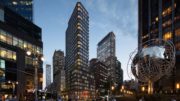Like people in a bar are prettier at closing time, new buildings are more attractive on desolate blocks of the city, like Glenwood’s 160 West 62nd Street. When an area long bereft of activity finally sprouts a tower, as long as it is inoffensive, New Yorkers are less likely to quibble about aesthetics. Perhaps this is most true for development enthusiasts in Detroit, where the occasional new building will be greeted as a Guggenheim Bilbao, regardless of its merits.
To a lesser extent, the tower under construction at 160 West 62nd Street has been greeted with much more praise in the blogosphere than it might have garnered had it been erected only a few blocks east. For the first time in a while, a building on this stretch of Amsterdam will greet pedestrians with its “face” rather than its rear-end.
Architecture critic James Gardner also saw 160 W. 62nd as praiseworthy for reasons not specifically related to the design. Gardner found the building’s facade merely passable, but liked the way in which the building towered over the new Fordham Law School building like a campanile.
It should be noted that, until the arrival of Glenwood’s building and the new Fordham law school, Damrosch Park was missing the signature feature of the iconic Manhattan park: a row of buildings of varying heights forming a wall on its border that contrasts with the greenery inside. 160 West 62nd helps provide Damrosch with a visually satisfying border, though this relationship is not repeated with its southern neighbor, the Alfred condominium.
160 West 62nd Street and the Alfred stand awkwardly kitty-corner to each other like gawky teenagers at a middle school dance. The fault lies largely with the Alfred, which – on its lower floors – presents a walled-off private park as well as a nearly windowless brick wall to Amsterdam Avenue. Comparatively, 160 West 62nd is gorgeous. It occupies a corner – the best place for 600 footers – there are no balconies, and its footprint is narrow enough to blend in rather than take over.
Nonetheless, those who maintain absolute standards for aesthetics likely won’t be satisfied with 160 West 62nd. Purists maintain a sort of Kantian categorical imperative when evaluating architecture: a building is considered good only if it would be deemed good if every architect designed buildings at that level. On the one hand, it’s important for people to maintain high standards to incentivize developers to pay for good design. On the other, the majority of buildings built in NYC from 1950 onward would fail if judged by a categorical imperative. And it has long been recognized that the strength of New York, aesthetically speaking, has been buildings viewed in arrangements, rather than as individuals.
A New York that sacrificed its most architecturally significant buildings but maintained its basic urban form would be quite drab, but not that different from the New York of today, while the loss of the street grid and associated vibrancy would be irreparable. In the end, the distribution of buildings and people in the city are as important – if not more important – than the designs of the buildings themselves. By plugging a hole in the street wall and promising to liven Amsterdam Avenue, 160 West 62nd Street meets the standard that urbanists should care about most.
Subscribe to YIMBY’s daily e-mail
Follow YIMBYgram for real-time photo updates
Like YIMBY on Facebook
Follow YIMBY’s Twitter for the latest in YIMBYnews

